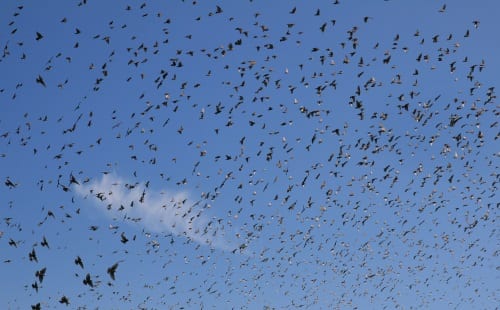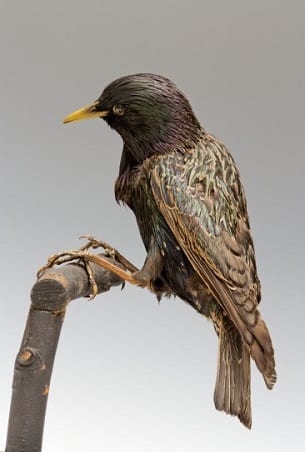Specimen of the Week 237: The Common Starling
By tcrnrh1, on 29 April 2016
1. A Familiar Sight
(… and long may that remain so!)
You may recognise this week’s sociable and rowdy Specimen of the Week: the Common Starling (Sturnus vulgaris). Starlings are familiar to many Brits, and SOTW blog readers from Europe, Asia, Africa and even those in northern Australia may also recognise this tenacious bird. Despite declining numbers in recent years they remain one of the UK’s most common garden birds. Starlings are especially profuse in southern England, often being sighted in towns and city centres as well as more rural areas.

A Common Starling – Sturnus vulgaris LDUCZ-Y1547. … The star of the show or in this case the Specimen of the Week Blog.
2. Is it a car alarm? Is it a phone? No! It’s a starling!
Starlings are renowned for their aptitude for mimicry and they have been known to emulate telephones and car alarms… much to the confusion of people around them! Such a skill makes their own calls difficult to distinguish from the birds’ songs they imitate and so their calls are often just described as a collection of squeaks, clicks and whistles. You can hear a clip of starling bird song on the British Birdsongs Website.
3. A Murmuration of Starlings
After closely examining this specimen it’s hard to imagine the magnificent scenes of thousands of starlings flocking together as they do before roosting. British cities such as Edinburgh, Newcastle and Manchester used to be famed for these spectacular sightings but these are unfortunately in decline and are now more frequently observed in rural areas. There are many reasons why starlings perform these striking visual displays. Firstly, grouping together offers safety from predators such as peregrine falcons by hiding weaker birds and by complicating the predator’s scheme to track one individual. Researchers also believe that starlings gather together to keep warm at night and to communicate information about bountiful feeding areas. There are some incredible videos of starling murmurations on YouTube, and you can get a sense of the mesmiring shapes these gatherings create by watching clips such as Paul Bunyard’s video.

Birds of a feather flock together. By Brocken Inaglory – Own work, CC BY-SA 3.0, https://commons.wikimedia.org/w/index.php?curid=8449362
4. Feathered Friends
Young starlings leave the nest covered with light brown feathers. As starling moulting is a gradual process, young starlings are often seen with a hybrid combination of light brown heads and new black feathers with bright white tips. Furthermore, during Autumn and Winter the white spots on common starlings are particularly pronounced which has resulted in the RSPB getting numerous calls about mysterious birds in peoples gardens. This starling specimen with its very sheeny dappled feathers of green and purple and it’s much less pronounced white spots is likely to have been collected during breeding season.

From a distance starlings look like blackbirds, but on closer inspection their sheeny feathers are dappled with flecks of purple and green. LDUCZ-Y1547
5. Human Interaction
Starlings are protected under the Wildlife and Countryside Act 1981 which means it is illegal to intentionally kill or harm a starling or damage an active nest or its contents. Common starlings are a red list species and their numbers in the UK have been declining since the 1980s. These tenacious and adaptable birds are have historically benefitted from the creation of buildings and open farmland. In return, starlings feed on invertebrates such as wireworms which are crop pests and therefore many people have encouraged starling nests through building nest boxes. However, such encouragement is believed to have caused the decline of other local species and has resulted in common starling inclusion on the IUCN’s List of the World’s 100 Worst Invasive Species. Such examples just hint towards the intertwinned and contested relationship between common starlings and humans.

A nesting starling in Southend-on-Sea, Essex. By Jans Canon – Starling Feeding Young. Uploaded by snowmanradio, CC BY 2.0, https://commons.wikimedia.org/w/index.php?curid=25268597
6. Taxidermy Technicalities
This mounted taxidermy specimen depicts the way starlings inquisitively cock their heads to the side to hear insects under ground. The ability to capture an animal’s characteristic movement or distinctive visual traits is one of the great advantages of taxidermy. In the museum visitors sometimes remark how skeletal specimens are difficult to comprehend without photographs of the animal in the wild. Thus taxidermy is a fantastic method to bridge this gap of comprehension. If you’re interested in seeing live taxidermy at the Grant Museum we have a free event coming up on 14th May called Under the Skin: Taxidermy Late. To join us you’ll need to book your ticket in advance on eventbrite.
Rachel Bray is the Learning and Events Assistant at the Grant Museum of Zoology.
 Close
Close


